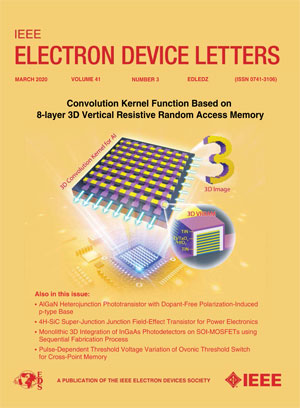Transistor-Structured Artificial Dendrites for Spatiotemporally Correlated Reservoir Computing
IF 4.5
2区 工程技术
Q2 ENGINEERING, ELECTRICAL & ELECTRONIC
引用次数: 0
Abstract
Neuromorphic electronics, which integrate sensing, storage, and computing to boost efficiency and performance, offer a low-cost, energy-efficient alternative for temporal data processing with edge computing potential when applied to reservoir computing (RC). However, current neuromorphic RC systems struggle with diverse spatial information inputs due to device design limits. Here, we present the first artificial dendrite horizontally cascaded by Ga-Sn-O (GTO)-based synaptic transistors with efficient electron-ion coupled films as the gate dielectric. This design allows unlimited lateral gate expansion, source/drain and gate interchangeability, and sustains a microampere-level output current across a record centimeter-scale gate-channel distance. The artificial dendrite maintains stable weight modulation through用于时空相关油藏计算的晶体管结构人工树突
神经形态电子学集成了传感、存储和计算,以提高效率和性能,为具有边缘计算潜力的时间数据处理提供了一种低成本、节能的替代方案,可用于油藏计算(RC)。然而,由于设备设计的限制,目前的神经形态RC系统难以处理不同的空间信息输入。在这里,我们提出了第一个人工枝晶水平级联的基于Ga-Sn-O (GTO)的突触晶体管,有效的电子-离子耦合薄膜作为栅介电介质。这种设计允许无限制的横向栅极扩展,源/漏极和栅极互换性,并在创纪录的厘米级栅极通道距离上维持微安级输出电流。人工枝晶通过$10^{\mathbf{{5}}}$电周期和$10^{\mathbf{{7}}}$弯曲周期保持稳定的重量调制,通过更换介电膜可恢复性能。这项工作开创了使用基于人工树突的RC系统进行时空相关油藏计算的先河,实现了高度精确的识别,并为该领域引入了一种新的范例。
本文章由计算机程序翻译,如有差异,请以英文原文为准。
求助全文
约1分钟内获得全文
求助全文
来源期刊

IEEE Electron Device Letters
工程技术-工程:电子与电气
CiteScore
8.20
自引率
10.20%
发文量
551
审稿时长
1.4 months
期刊介绍:
IEEE Electron Device Letters publishes original and significant contributions relating to the theory, modeling, design, performance and reliability of electron and ion integrated circuit devices and interconnects, involving insulators, metals, organic materials, micro-plasmas, semiconductors, quantum-effect structures, vacuum devices, and emerging materials with applications in bioelectronics, biomedical electronics, computation, communications, displays, microelectromechanics, imaging, micro-actuators, nanoelectronics, optoelectronics, photovoltaics, power ICs and micro-sensors.
 求助内容:
求助内容: 应助结果提醒方式:
应助结果提醒方式:


